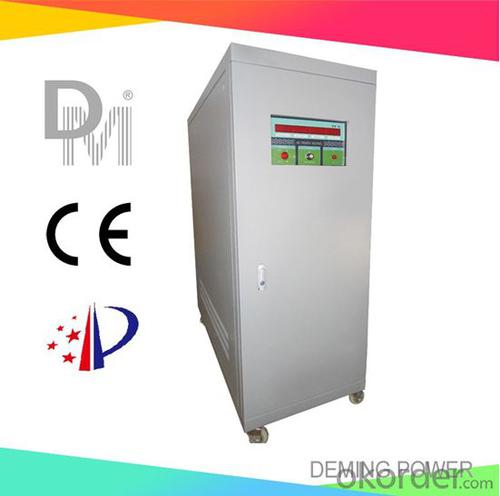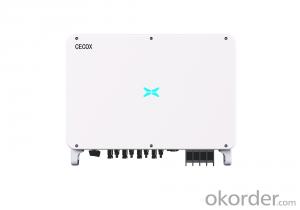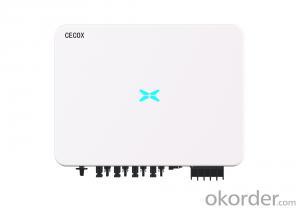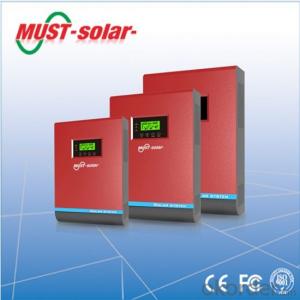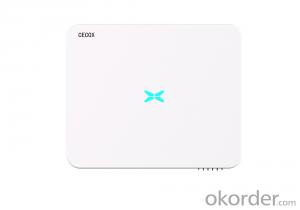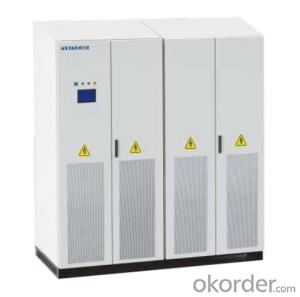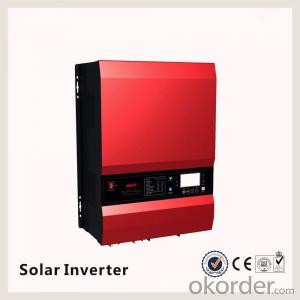Solar Inverter 12v 50kw Off Grid Three Phase Photovoltaic Inverter
- Loading Port:
- China main port
- Payment Terms:
- TT or LC
- Min Order Qty:
- 50000 watt
- Supply Capability:
- 3000000 watt/month
OKorder Service Pledge
OKorder Financial Service
You Might Also Like
1. Structure of Photovoltaic Inverter 50KW Off Grid Three Phase
A solar inverter, or PV inverter, or Solar converter, converts the variable direct current (DC) output of a photovoltaic (PV) solar panel into a
utility frequency alternating current (AC) that can be fed into a commercial electrical grid or used by a local, off-grid electrical network. It is
a critical BOS–component in a photovoltaic system, allowing the use of ordinary AC-powered equipment. Solar inverters have special
functions adapted for use with photovoltaic arrays, including maximum power point tracking and anti-islanding protection.
2. Main Features of Photovoltaic Inverter 50KW Off Grid Three Phase
• using IGBT from Mitsubishi company as the power components
•using American ATEMEL company microprocessor as figure controller
• perfect protection and warning functions
• circuit frame compact,Max. Efficiency≥94%
• with wide input voltage range
• RS232/485 communication,multi communication interface can be selected
•big-screen English LCD, perfect display, interface-friendly
3. Photovoltaic Inverter 50KW Off Grid Three Phase Images
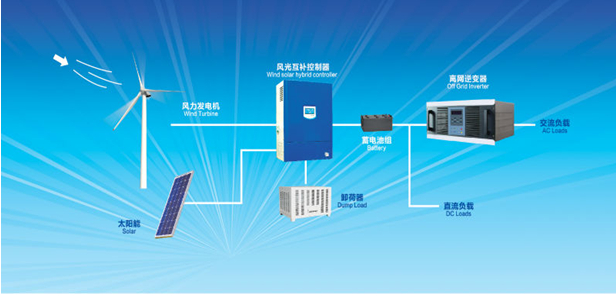

4. Photovoltaic Inverter 50KW Off Grid Three Phase Specification
窗体顶端 50KVA off grid three phase inverter technical parameters 窗体底端 | |||
Type | ND220-50KS | ND380-50KS | |
DC input | Input rated voltage | 220 VDC | 380 VDC |
Input rated current | 227 A | 132 A | |
Input DC voltage range | 180-300 VDC | 300-490VDC | |
| Allow input voltage range | 220 VAC / 380 VAC / 400 VAC ± 15% VAC | |
AC input | Input rated current | 139A / 76A / 72.5A | |
| Bypass transfer time | ≤4 ms | |
AC output | Rated capacity | 50KVA | |
Output rated power | 40KW | ||
Output rated voltage and frequency | 220 VAC / 380 VAC / 400 VAC,50Hz / 60Hz | ||
Output rated current | 139A / 76A / 72.5A | ||
Output voltage accuracy | 220 VAC / 380 VAC / 400 VAC ± 2% | ||
Output frequency accuracy | 50Hz / 60Hz ±0.05% | ||
Waveform distortion (THD). (Linear load) | ≤3% | ||
Dynamic response time (Load 0←→100%) | 2ms | ||
Power factor (PF) | 0.8 | ||
Overload capacity | 120%,3 minutes,150%,10 second | ||
Crest factor (CF) | 3:01 | ||
Inverter efficiency | 94% | ||
Working Environment | Dielectric strength | 1500VAC,1minute | |
Noise (1m) | ≤50dB | ||
Ambient temperature | -10℃~+50℃ | ||
Humidity | 0~90%,No condensation | ||
Altitude | ≤5000 m | ||
Production function | Input reverse protection, input under-voltage protection, output overload protection, output short circuit protection, thermal protection | ||
5. FAQ of Photovoltaic Inverter 50KW Off Grid Three Phase
Q1:Can we visit your factory?
A1:Sure,welcome at any time,seeing is believing.
Q2:Which payment terms can you accept?
A2:T/T,L/C,Moneygram,Paypal are available for us.
- Q: Can a solar inverter be used with different types of backup power configurations?
- Yes, a solar inverter can be used with different types of backup power configurations. Solar inverters are designed to convert the DC power generated by solar panels into AC power that can be used to power electrical devices and appliances. They can be integrated with various backup power systems such as batteries, generators, or grid connections to provide uninterrupted power supply during periods of low solar generation or power outages. The versatility of solar inverters allows for flexibility in choosing and combining backup power sources based on specific needs and preferences.
- Q: What is the role of a solar inverter in net metering?
- The role of a solar inverter in net metering is to convert the direct current (DC) electricity produced by solar panels into alternating current (AC) electricity that can be used to power homes or businesses. It also allows any excess electricity generated to be fed back into the grid, enabling net metering and allowing the owner to receive credits or compensation for the excess energy provided.
- Q: What is the maximum power capacity that a solar inverter can handle?
- The maximum power capacity that a solar inverter can handle varies depending on the specific model and brand. However, modern solar inverters can typically handle power capacities ranging from a few hundred watts to several megawatts.
- Q: Can a solar inverter be used with different types of tracking algorithms?
- Yes, a solar inverter can be used with different types of tracking algorithms. The primary function of a solar inverter is to convert the direct current (DC) generated by solar panels into alternating current (AC) that can be used in homes or businesses. Tracking algorithms, on the other hand, are responsible for optimizing the performance of solar panels by adjusting their orientation and tilt angles to maximize sunlight exposure. Solar inverters can integrate with various tracking algorithms to ensure efficient operation and improve energy generation.
- Q: What is a solar inverter?
- A solar inverter is an electronic device that converts the direct current (DC) electricity generated by solar panels into alternating current (AC) electricity, which is suitable for use in homes, businesses, and the electrical grid.
- Q: Can a solar inverter be used with a grid-tied system and a battery backup?
- Yes, a solar inverter can be used with a grid-tied system and a battery backup. The solar inverter is responsible for converting the direct current (DC) generated by the solar panels into alternating current (AC) that can be used to power appliances and feed back into the grid. In a grid-tied system with a battery backup, the solar inverter can also charge the batteries during the day when there is excess solar energy. This allows for the stored energy in the batteries to be used during power outages or when the grid is not available.
- Q: Are there any safety risks associated with solar inverters?
- Yes, there are potential safety risks associated with solar inverters. These risks can include electrical hazards, such as electric shock or fire, especially if the inverter is not installed or maintained correctly. Additionally, there is a possibility of arc flash incidents and potential exposure to high voltage DC electricity. It is important to follow proper installation and maintenance procedures, as well as adhere to safety guidelines provided by manufacturers and professionals, to mitigate these risks and ensure safe operation of solar inverters.
- Q: Can a solar inverter be used with a solar-powered cooling system?
- Yes, a solar inverter can be used with a solar-powered cooling system. A solar inverter is responsible for converting the direct current (DC) electricity generated by solar panels into alternating current (AC) electricity that can be used to power various appliances, including cooling systems. By integrating a solar inverter into a solar-powered cooling system, the system can effectively harness solar energy to operate and provide cooling without relying on external power sources.
- Q: What is the maximum efficiency rating of a solar inverter?
- The maximum efficiency rating of a solar inverter can vary depending on the specific model and technology used, but generally, the highest efficiency ratings can range from 95% to 99%.
- Q: Can a solar inverter be used in areas with unstable grid power?
- Yes, a solar inverter can be used in areas with unstable grid power. In fact, solar inverters are often used in such areas to provide a stable and reliable power supply. The inverter's ability to convert solar energy into usable electricity allows it to function independently of the grid power, ensuring a continuous power supply even during grid outages or fluctuations.
Send your message to us
Solar Inverter 12v 50kw Off Grid Three Phase Photovoltaic Inverter
- Loading Port:
- China main port
- Payment Terms:
- TT or LC
- Min Order Qty:
- 50000 watt
- Supply Capability:
- 3000000 watt/month
OKorder Service Pledge
OKorder Financial Service
Similar products
Hot products
Hot Searches
Related keywords


